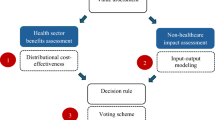Abstract
Background: When Medicaid preferred drug lists (PDLs) are implemented, they may impose indirect costs on prescribing physicians and Medicaid patients, leading to an unintended reduction in the number of Medicaid prescriptions filled.
Objective: To test retrospectively the proposition that PDLs adversely affect the number of Medicaid prescriptions filled.
Data and methods: We compared three ‘test’ states (Alabama, Texas, and Virginia) that implemented PDLs with restrictions on the prescription of statins with three ‘control’ states (New Jersey, North Carolina, and Pennsylvania) that did not implement drug access restrictions. We conducted the analysis at the county level and used a differences-in-differences approach that allows for county and time-period fixed effects.
Results: We found that PDLs adversely impacted several measures of filled Medicaid prescriptions in the ‘test’ states relative to the ‘control’ states.
Conclusion: There are unintended but potentially harmful consequences to cost-focused health policy interventions.
Similar content being viewed by others
References
Rosenbaum S. Racial and ethnic disparities in healthcare: issues in the design, structure, and administration of federal healthcare financing programs supported through direct public funding. In: Smedley, Stith, Nelson, editors. Unequal treatment: confronting racial and ethnic disparities in health care. Washington, DC: The National Academies Press; 2003. 664–98
Rice T. The impact of cost containment efforts on racial and ethnic disparities in healthcare: a conceptualization. In: Smedley, Stith, Nelson, editors. Unequal treatment: confronting racial and ethnic disparities in health care. Washington, DC: The National Academies Press; 2003. 699–721
Institute of Medicine. In: Smedley, BD, Stith, AY, Nelson, AR, editors. Unequal treatment: confronting racial and ethnic disparities in health care. Washington, DC: The National Academies Press; 2003.
Lillie-Blanton M, Hoffman C. The role of health insurance coverage in reducing racial/ethnic disparities in health care. Health Affairs 2005; 24: 398–408
Seay M, Varma P. Pharmaceuticals: pharmaceutical cost controls — 2005. End of year issue brief. Issue Brief Health Policy Track Serv 2005; 1–20.
Soumerai SB. Benefits and risks of increasing restrictions on access to costly drugs in medicaid. Health Affairs 2004; 23: 135–46
Murawski MM, Abdelgawad T. Exploration of the impact of preferred drug lists on hospital and physician visits and the costs to medicaid. Am J Manag Care 2005; 11 (Special Issue): S35–42
Texas Health and Human Services Commission. Preferred drug list annual report. 2005. Available from: http://www.hhsc.state.tx.us/hcf/vdp/reports/010105_PDLAR.pdf. [Accessed 2006 Aug 1].
Department of Medical Assistance Services. Virginia’s preferred drug list: program implementation outcomes and recipient health effects. 2005. Available from: http://www.dmas.virginia.gov/downloads/studies_reports/2005-RD214.pdf. [Accessed 2006 Aug 1].
Alabama Medicaid Agency. Preferred drug and prior authorization program, criteria and instructions booklet. 2006. Available from: http://www.hidmedicaid.com/Forms/Criteria_Instruction_Booklet_10-2-06.pdf. [Accessed 2006 Aug 1].
US Census Bureau. 1999 US postal service zip codes. Available from: http://www.census.gov/geo/www/tiger/zip1999.zip. [Accessed 2006 Feb 1].
US Census Bureau. Annual estimates of the population for counties: April 1 2000 to July 1 2005. Available from: http://www.census.gov/popest/counties/CO-EST2005-01.html. [Accessed 2006 Feb 1].
US Census Bureau. Census 2000 summary file 3 (sf 3). Available from: http://factfinder.census.gov/servlet/DatasetMainPageServlet?_ds_name=DEC_2000_SF3_U&_program=DEC&_lang=en. [Accessed 2006 Feb 1].
Bertrand M, Duflo E, Mullainathan S. How much should we trust differences-in-differences estimates? Quart J Econ 2004; 119: 249–75
Author information
Authors and Affiliations
Corresponding author
Rights and permissions
About this article
Cite this article
Abdelgawad, T., Egbuonu-Davis, L. Preferred Drug Lists and Medicaid Prescriptions. PharmacoEconomics 24 (Suppl 3), 55–63 (2006). https://doi.org/10.2165/00019053-200624003-00005
Published:
Issue Date:
DOI: https://doi.org/10.2165/00019053-200624003-00005




